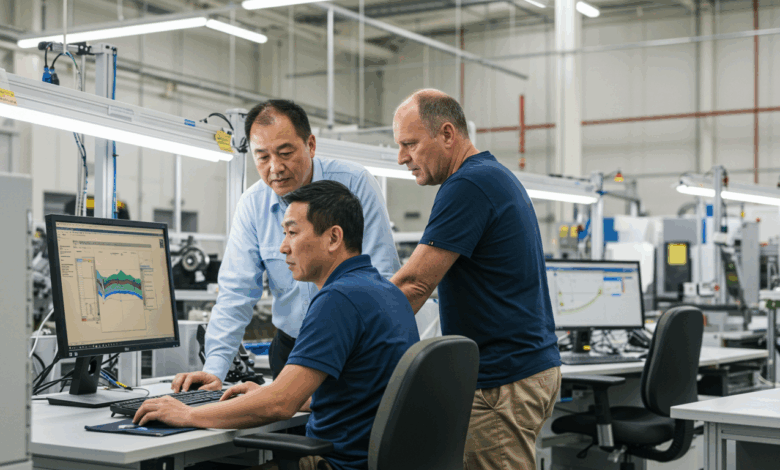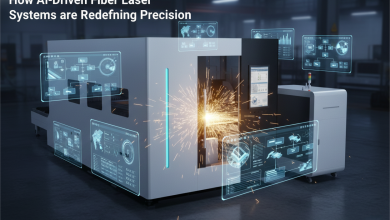
The idea that artificial intelligence (AI) is the future of manufacturing is no longer controversial. The critical question now is how long companies can afford to wait with AI adoption before the “future” leaves them behind.
There was a time – not too long ago – when adopting AI for the shop floor was a sign of being ahead of the curve – a badge of innovation. Today, it’s starting to look like something else: a litmus test for whether a company is ready for the future. The early adopters aren’t experimenting with AI anymore, they’re streamlining operations, reducing defects, cutting downtime, and steadily widening the performance gap between themselves and those waiting on the sidelines.
The uncomfortable truth? What was once a competitive advantage for manufacturers is quickly becoming table stakes.
AI Is a Competitive Edge – For Now
Manufacturing has never been short on buzzwords. “Smart factories,” “Industry 4.0,” and “digital transformation” have all taken turns on slide decks and reports from consulting firms. But peel away the hype and look at the substance: manufacturers using AI today are solving real, practical problems.
AI is helping detect subtle quality issues that humans and rule-based systems miss. It’s forecasting equipment failures before they disrupt production. It’s spotting inefficiencies that were invisible in mountains of sensor and process data. And it’s doing it amazingly reliable and affordable.
Crucially, even initial, often small but high-impact deployments generate substantial returns. A single AI-driven inspection station can pay for itself in months by preventing a batch of defective parts from reaching a customer or by significantly reducing scrap rates. A basic predictive maintenance model can eliminate costly unplanned downtime on a bottleneck machine.
Fully autonomous, “lights out” factories might be the ultimate goal – the path there is adoption of AI for applications that quickly generate value and then build out a comprehensive AI solution based on a flexible platform that enables broad adoption and integration over time.
But here’s the catch: the more companies adopt AI for these use cases, the less exceptional these gains become. When your competitor reduces scrap by 15% or slashes changeover delays by using AI to simplify setup of equipment, that’s their competitive advantage. When everyone does it, it’s just the cost of staying in the game.
The Illusion of Optionality
Many manufacturers – particularly in capital-intensive or lower-margin industries – have taken a wait-and-see approach to AI. There’s a tendency to treat it like an interesting but perhaps not quite essential novelty. That assumption is increasingly risky.
Because AI doesn’t just deliver operational benefits. It reshapes expectations across the value chain.
If your customer gets used to defect-free parts from a supplier running AI-enhanced inspection, your 2% defect rate suddenly looks like negligence. If a competitor offers shorter lead times or faster changeovers because they’ve optimized planning with AI, your manual process isn’t “robust” – it’s slow.
And as procurement teams become more data-savvy and performance-focused, they will start treating the absence of AI not as neutral, but as a liability.
This shift doesn’t happen overnight. But it does happen quietly, then all at once. And when it does, AI isn’t something you adopt to get ahead. It’s something you need just to keep up.
From Pilot Purgatory to Operational Impact
Let’s be clear: adopting AI in manufacturing isn’t plug-and-play. It takes work: data infrastructure, system integration, change management – none of it is trivial. But it needs to be done and the best time to get started was a couple of years or so ago, the second best is today.
Too many companies are still stuck paying lip service to AI adoption, or have adopted low hanging fruit: using ChatGPT to help writing reports is useful but it won’t make a difference on the shop floor. Pilot projects and proof-of-concept studies are an important first step – but there needs to be a path to operationalization, a strategy and a roadmap.
In some cases, manufacturers are targeting the wrong problems: trying to use AI to fix long-standing bottlenecks that five other initiatives have already failed to resolve. In others, they underestimate the data requirements or overestimate what off-the-shelf models and a data scientist fresh out of college can do.
And often, the biggest obstacle isn’t technology. It’s culture.
There’s a lingering mindset that AI is a special project: something to be tried cautiously, on the side, in a lab – not deployed on the line. As long as that mindset persists, the benefits will remain theoretical.
What separates companies making progress from those that aren’t is the willingness to treat AI as part of the core business, not a peripheral experiment.
AI Fluency as a Strategic Capability
Another emerging divide isn’t just who uses AI—it’s how well they use it.
Being able to run a pilot is one thing. Building internal capabilities to identify good use cases, manage data flows, interpret model outputs, and make decisions based on AI insights – that’s something else entirely.
Companies that build this kind of fluency now are not just solving today’s problems. They’re setting themselves up to respond faster to tomorrow’s. And they are building deep, hard-earned know-how that’s difficult for competitors to replicate quickly.
It’s not about hiring data scientists by the dozen. It’s about empowering engineers, operators, and quality teams to work effectively with AI-powered tools. It’s about the cross-functional collaboration needed to implement AI solutions. That’s the difference between using AI as a one-off trick and using it as a sustained source of value.
The Window Is Closing
The idea that “there’s still time” is comforting – but the window is closing. AI adoption, like any technology cycle, follows a curve. Once it passes a certain threshold, laggards don’t just lose ground, they find themselves shut out of certain markets entirely.
Consider what happened with automation in automotive. Companies that didn’t invest early found themselves priced out, unable to meet volume or consistency targets. The same dynamic is playing out with AI, only faster.
For manufacturers in highly competitive, price-sensitive, or compliance-heavy markets, the absence of AI will soon be more than just a missed opportunity, it will be an operational risk. Imagine trying to win contracts without traceability, without real-time quality data, without the ability to respond to variability with speed.
What to Do Now – Without the Hype
If AI is moving from advantage to necessity, the question becomes: what should manufacturers do?
Some practical suggestions:
- Start with real pain points. Don’t chase AI for its own sake. Identify problems that cost you money, time, or reputation and that can realistically be solved with the data you already have or can reasonably collect.
- Avoid the moonshot mentality. Not every use case needs to be groundbreaking. Modest improvements that scale are more valuable than flashy proofs-of-concept that don’t.
- Invest in readiness, not perfection. You don’t need a perfect dataset or fully integrated system to start. But you do need clear ownership, cross-functional buy-in, and the willingness to iterate.
- Make AI part of operations, not innovation theatre. Move successful pilots into the real world. Set KPIs. Integrate with existing systems. Let operators and engineers take ownership.
- Plan for scale early. The hardest part isn’t getting one model to work, it’s making many work in different parts of the plant, across shifts, machines, or lines. Start with a high-value use case but think about your platform and how to scale from the start.
A Final Thought: Who Owns the Future?
There’s a certain irony in how AI is viewed in manufacturing. It’s often treated as futuristic, while the problems it solves – defects, downtime, inefficiencies, scrap – are old and familiar. But that’s exactly the point.
AI isn’t about transforming manufacturing into something else. It’s about finally solving intractable problems that have plagued the industry for far too long.
The companies that grasp this are already pulling ahead. For everyone else, the question isn’t whether AI will become necessary. It’s whether you’ll be ready when it does.
About Accella AI
Accella AI provides cutting-edge AI-enabled solutions for manufacturing companies that allow them to reduce cost, improve quality, and better utilize existing personnel and equipment.
Additional information, blogs and use cases can be found on the website.
Contact:
Uli Palli




